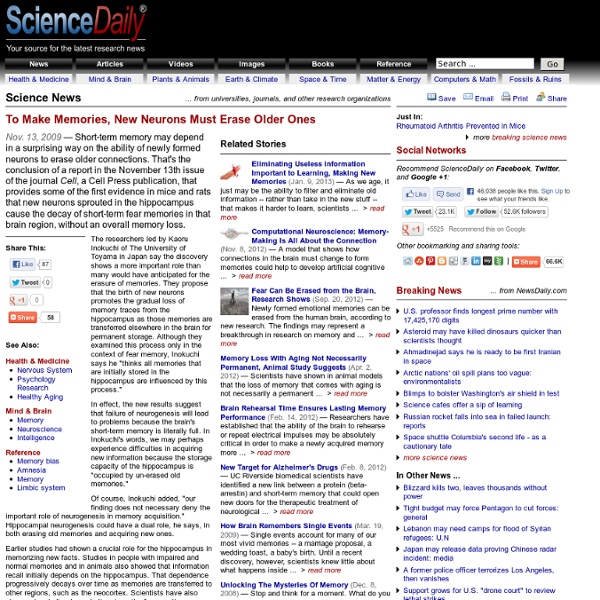To make memories, new neurons must erase older ones

The Cloud and Collaboration
Paper written as a contribution to the Ars Electronica symposium on Cloud Intelligence. Let's take as a starting point the discussion of 'cloud intelligence' on the conference website: In the cloud of connections, we each become social neurons, mimicking the biological human brain but on a giant scale. This idea of the connected world as a global brain is not new, nor surprising. Peter Russell's The Global Brain explicitly makes the connection. We have already noted that there are, very approximately, the same number of nerve cells in a human brain as there are human minds on the planet. According to Russell, the brain develops in two phases. Tom Stonier writes, In principle, this process does not differ from the evolution of primitive nervous systems into advanced mammalian brains... each node, rather than being a neuron, is a person comprising trillions of neurons ... coupled ... to their personal computers... We think together but remain independent in our identity. 80+1. (2008).
Brain innately separates living and non-living objects for proce
For unknown reasons, the human brain distinctly separates the handling of images of living things from images of non-living things, processing each image type in a different area of the brain. For years, many scientists have assumed the brain segregated visual information in this manner to optimize processing the images themselves, but new research shows that even in people who have been blind since birth the brain still separates the concepts of living and non-living objects. The research, published in today's issue of Neuron, implies that the brain categorizes objects based on the different types of subsequent consideration they demand—such as whether an object is edible, or is a landmark on the way home, or is a predator to run from. They are not categorized entirely by their appearance. "When we looked at the MRI scans, it was pretty clear that blind people and sighted people were dividing up living and non-living processing in the same way," says Mahon. Story source
Artificial Neural Network Lab: Java applets and GIF-animation
Artificial Neural Network Lab on the Web (To Japanese version) Demonstrations on artificial neural networks using java-applets and GIF-animations Bayesian Self-Organizing Maps (BSOM) The figures show an example of probability density distribution estimated by BSOM. Other Neural Networks Applets for Neural Networks and Artificial Life Link collection for pages using applets for the demonstration of neural networks and artificial life. My research and articles Akio Utsugi (home page)
An Analog Artificial Neural Network as Art
Phil Stearns has constructed a 45 “neuron” network of electronic parts which responds to lights and tones with a (rather cute) squealing sound. A picture of the components for this strange device: Each “neuron” consisted of analog electronics corresponding to each of 6 functions: Input, Summing, Threshold, “Offset,” “Output,” and “Structure” (not sure about those latter three). The connectivity was determined by hand. Phil states that the sculpture is not intelligent, but rather “some kind of squid baby.” Neural networks have great potential for contributing to the arts. Here’s some art from a portion of rat brain placed into a petri dish: And, of course, there’s Jonathan McCabe‘s fantastic network art: Jon McCabe’s process is perhaps the most interesting. It sounds like none of these networks were trained to produce good art – but they seem to have some “natural” talent regardless!
Related:
Related:



